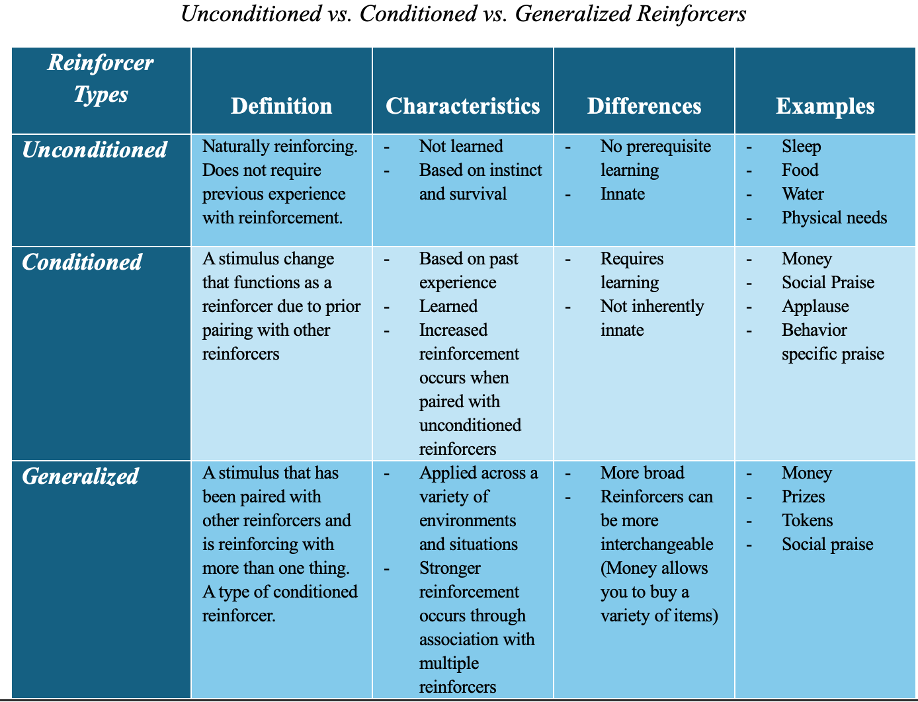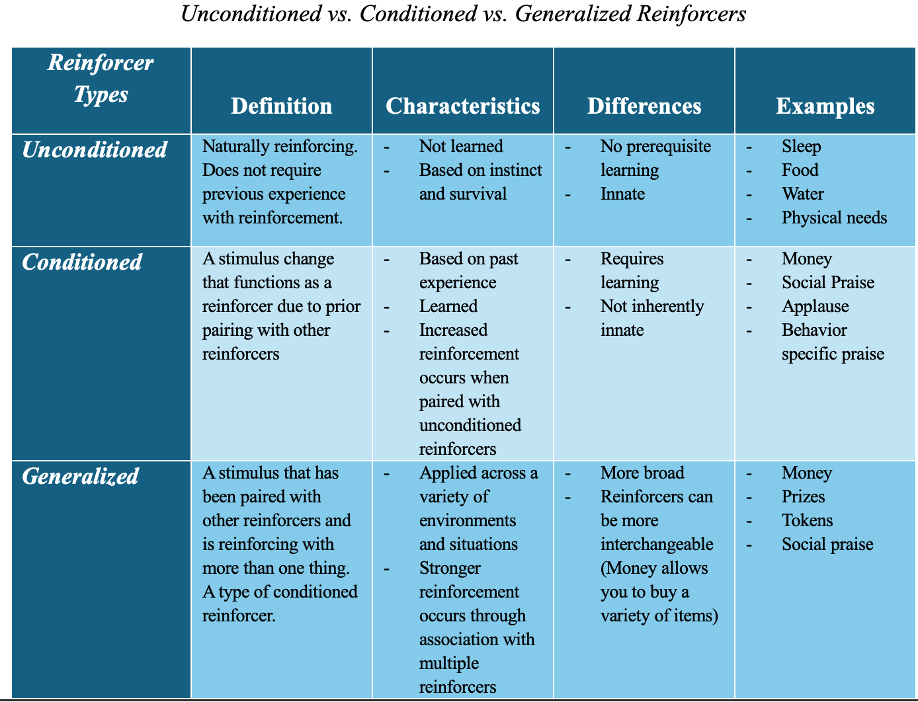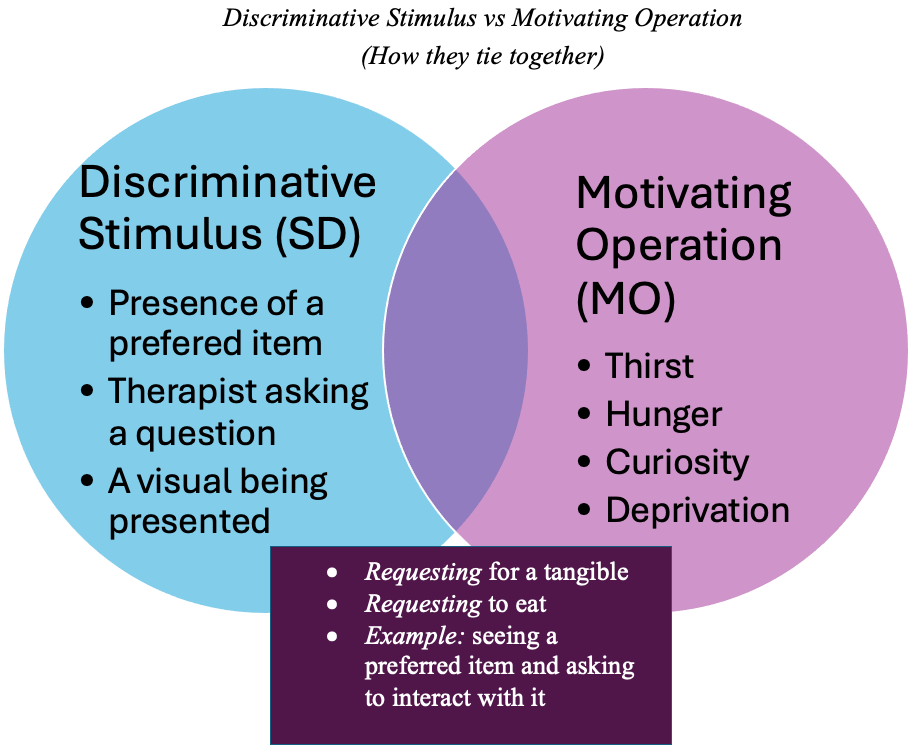SPCE 609: Introduction to Applied Behavior Analysis
1/70
Earn XP
Description and Tags
Flashcards to aid in reviewing key concepts in Applied Behavior Analysis for exam preparation.
Name | Mastery | Learn | Test | Matching | Spaced |
|---|
No study sessions yet.
71 Terms
The goals of behavior analysis include __, __, and __.
description, prediction, control.
The philosophical assumptions underlying behavior analysis are selectionism, determinism, __, parsimony, and __.
empiricism, pragmatism.
Radical Behaviorism considers both __and __events to understand behavior.
public, private
Behaviorism is the philosophy of __, which occurs through interactions with the __.
science of behavior, environment
There are 7 dimensions of Applied Behavior Analysis which include:
Behavioral, Analytic, Technological, Conceptually Systematic, Applied, Generality, and Effective
A ____ describes specific instances of behavior while a ____ ____describes different behaviors that share the same function but have different topographies.
response, response class.
___conditioning involves conditioning reflexes, it is also known as ___conditioning.
Respondent, classical
Positive reinforcement contingencies describe the likelihood a behavior will occur again in the future after __ a desirable stimulus.
adding
Negative reinforcement contingencies describe the likelihood a behavior will occur again in the future after __ an undesirable stimulus.
removing
Positive punishment involves __ a stimulus to decrease a behavior while negative punishment involves ___ a stimulus.
adding, removing
Automatic contingencies are ___of others while socially mediated contingencies are ___ by others.
independent, reinforced or punished
Unconditioned reinforcers are stimuli that can increase future occurrences of behavior without prior __ with any form of reinforcement.
pairing
Generalized reinforcers are types of conditioned reinforcers that are reinforcing across __ environments and situations.
multiple
Concurrent schedules of reinforcement involve two or more schedules presented at the same time, allowing individuals to __ one to respond to.
choose
Operant extinction occurs when a previously reinforced behavior no longer __, leading to a decrease over time.
receives reinforcement
Motivating operations affect the value of a __ or stimulus change, influencing behavior.
reinforcer
____behaviors do not require direct experience with consequences, whereas ___shaped behaviors are shaped through experience with contingencies.
Rule-governed, contingency
Verbal operants include mand, tact, __, and __.
echoic, intraverbal
Multiple control in verbal behavior can be divided into __ multiple control and __ multiple control.
divergent, convergent
Two parents are very tired because they work hard and are trying to raise a young child. The child begins crying. When they put their child in their own bed, the child stops crying. Therefore, in the future, the parents are more likely to put the child in their own bed.
The parents have reinforced putting the child in their bed via negative reinforcement because it stops the aversive crying.
One advantage of free operant preference assessments is
they can be less time consuming than trial-based assessments
to increase the likelihood of that behavior occurring in the future.
by providing reinforcement based on variability in responses. This encourages individuals to produce a range of responses rather than just repeating the same behavior.
When implementing response cost, the practitioner must makes a note of the individual’s engagement in the problem behavior each time while removing the relevant amount of the reinforcer. This may reinforce the behavior with attention
make a note of the individual’s engagement in the problem behavior each time while removing the relevant amount of the reinforcer. This may reinforce the behavior with attention that can unintentionally maintain or strengthen the problem behavior.
Desirable aspects of nonexclusion time-out include:
its acceptability to the general public, and its ease of application
In order for the withdrawal of a stimulus to successfully suppress an individual’s behavior, the stimulus…
must be a reinforcer that was previously effective in maintaining the behavior.
Who is considered the founder of the experimental analysis of behavior?
B.F. Skinner is and he is known for his work on operant conditioning, particularly the concept of reinforcement and punishment.
This approach focuses on the relationship between behavior and its consequences, helping to identify the function of a behavior in terms of what it achieves for the individual.
but does not confirm that observations are correct. Accuracy must be validated by comparing observed data with a true value.
Divergent Multiple Control
refers to a situation where a single behavior is influenced by multiple contextual factors or stimuli, demonstrating that the same behavior can result from different variables.
Convergent Multiple Control
describes a scenario where multiple behaviors are influenced by a single contextual factor, indicating that different behaviors can stem from the same stimulus.
1. Which is NOT a dimension of Applied Behavior Analysis?
a. Technological
b. Effective
c. Parsimony
d. Generality
e. Conceptually Systematic

C. Parsimony, as it refers to simplicity in explanations rather than a dimension of ABA.
1. Which best describes the difference between Experimental analysis of behavior and Applied Behavior Analysis?
a. EAB focuses on socially significant behaviors, while ABA is only used in a lab setting
b. ABA is primarily theoretical, while EAB is applied in clinical/research settings.
c. ABA is applied in clinical/research settings, while EAB is used in both research and real-world settings.
d. EAB is more research focused, while ABA focuses on socially significant behaviors in real world settings.
e. None of the above, they are functionally the same

D. EAB is more research focused, while ABA applies socially significant behaviors in real-world settings.
1. What makes Radical Behaviorism different from other forms of behaviorism?
a. It does not consider private events and focuses only on what can be observed and measured.
b. It rejects distinguishing reinforcement and punishment as positive or negative.
c. It views private events as outside the realm of science
d. It considers both public and private events to understand behavior
e. It views behavior as independent of past behaviors

D. It considers both public and private events to understand behavior, emphasizing the importance of inner experiences in behavior analysis.
Which of the following describes Parsimony?
a. Ruling out the simplest explanation first before exploring other explanations.
b. Ruling out environmental factors when analyzing behaviors.
c. Only using interventions that show real-world changes on behaviors.
d. Excluding private events when considering behavioral functions.
e. Considering complex explanations to analyze behavioral events.

A. Ruling out the simplest explanation first before exploring other explanations.
5. Which of the following does not describe the goal of Prediction in ABA?
a. Correlation
b. Description
c. Prediction allows for preparation
d. Causal Relations
e. Repeated observations that two events covary with each other

B. Description does not describe the goal of Prediction in ABA, as it focuses on explaining how behaviors occur rather than anticipating their occurrence.
Which of the following describes behavior from an ABA perspective?
a. Behavior is anything an organism does
b. Behaviors can be grouped based on shared functions with different topographies, known as response classes
c. A specific instance of behavior is known as a response
d. The definition of behavior includes some form of movement from the organism, both voluntary and involuntary.
e. All of the above, except D

E. All of the above, except D, describe behavior from an ABA perspective, emphasizing the broad definitions and classifications of behavior.
Which of the following is true about respondent conditioning and operant conditioning?
a. Operant conditioning is also referred to as classical conditioning
b. Respondent conditioning is used more in ABA than operant conditioning
c. Operant and respondent conditioning occur automatically
d. Operant conditioning uses consequences in selecting behavior, while respondent conditioning is focused on the response, conditioning reflexes through antecedent stimuli
e. Respondent conditioning mainly uses reinforcement, operant conditioning uses punishment

D. Operant conditioning uses consequences in selecting behavior, while respondent conditioning is focused on the response, conditioning reflexes through antecedent stimuli.
Which is the best example of negative reinforcement?
a. Examples include verbal praise or tokens
b. A person buys coffee every time they leave for work early, increasing the likelihood they will wake up earlier
c. A student is allowed to avoid a quiz if they complete a review assignment, this increases the likelihood they will study more
d. A dog is given a treat every time they give paw when asked to, increasing the likelihood the behavior will occur in the future
e. A driver receives a ticket for not stopping at a stop sign, increasing the likelihood they will stop at stop signs more often.

C. A student is allowed to avoid a quiz if they complete a review assignment, which increases the likelihood they will study more, is the best example of negative reinforcement.
Which statement is false?
a. Socially mediated contingencies prioritize punishment over reinforcement
b. Socially mediated contingencies are reinforced by others
c. Eating until you feel full in an example of an automatic contingency
d. Automatically mediated contingencies occur naturally
e. A student receiving a prize for completing all their work is an example of a socially mediated contingency

A. Socially mediated contingencies prioritize punishment over reinforcement is false.
Which statement is true about positive punishment?
a. An example of positive punishment is a student receiving extra credit for answering an additional question, increasing the likelihood
b. Positive punishment is preferred over negative punishment
c. A desirable stimulus is removed to increase the behavior
d. It involves adding a desirable stimulus to decrease the likelihood of a behavior occurring again
e. A desirable stimulus is used to increase motivation

D. It involves adding an aversive stimulus to decrease the likelihood of a behavior occurring again.
What is the difference between conditioned and generalized reinforcers?
a. An example of a generalized reinforcer is money
b. They are interchangeable terms
c. All generalized reinforcers are conditioned reinforcers, but not all conditioned reinforcers are generalized.
d. Generalized reinforcers can be associated with more than one primary reinforcer, but conditioned reinforcers are associated with only one.
e. Conditioned reinforcers can be associated with more than one primary reinforcer, but generalized reinforcers are associated with only one.

D. Generalized reinforcers can be associated with multiple primary reinforcers, while conditioned reinforcers are linked to only one.
Which of the following are examples of motivating operations?
a. Hunger
b. Thirst
c. Being full after eating
d. Deprivation
e. A, B, and C

e. A, B, and D are examples of motivating operations that can influence the effectiveness of reinforcers.
Which reinforcement schedule consists of two or more schedules of reinforcement that are applied simultaneously, each with its own set of contingencies?
a. Mixed
b. A and C
c. Multiple
d. Chained
e. Concurrent

e. Concurrent reinforcement schedule consists of two or more schedules that operate simultaneously, each with distinct contingencies.
Which of the following is NOT an example of stimulus control?
a. Stopping at a stop sign and driving behaviors
b. Ignoring a red light
c. Following a teacher’s instructions and class behavior
d. A dog giving paw after presenting an instruction paired with a treat
e. Stopping at a red light

b. Ignoring a red light is not an example of stimulus control, as it indicates a failure to respond to the stimulus.
Which of the following is NOT true of respondent extinction?
a. A conditioned response will gradually decrease and then disappear after conditioned stimulus is no longer paired with unconditioned stimulus
b. Involves stopping reinforcement to decrease a behavior over time
c. A dog no longer salivating from the sound of a bell after reinforcement is no longer given is an example of respondent extinction
d. The behavior no longer being reinforced will become stronger and more frequent
e. B and D

e. B and D are not true statements about respondent extinction, as it refers specifically to the gradual decrease of a conditioned response when the conditioned stimulus is no longer paired with the unconditioned stimulus, rather than causing behaviors to increase.
Which of the following is NOT an example of stimulus control?
a. Stopping at a stop sign and driving behaviors
b. Ignoring a red light
c. Following a teacher’s instructions and class behavior
d. A dog giving paw after presenting an instruction paired with a treat
e. Stopping at a red light

b. Ignoring a red light is considered a lack of stimulus control, as it demonstrates a failure to respond to the relevant stimulus.
Which of the following is an example of a motivating operation and which is an example of stimulus control?
a. You get an email about an upcoming sale for your favorite store. You get excited and shop because this store has previously had good deals.
b. A child is cold. They see a sweatshirt, but don’t put it on. They remain cold.
c. A child is cold. They see a sweatshirt and put it on. They are no longer cold. They are more likely to put on a sweatshirt when cold in the future.
d. A is an MO, and C is stimulus control; B is a non-example
e. C is an MO, and A is a stimulus control; B is a non-example.

E. C is an MO, and A is an example of stimulus control; B is a non-example.
Which of the following are examples of the rule-governed behaviors?
a. You stop at a red-light
b. You take vitamins your doctor recommends
c. You stop at a red-light after previously being ticketed
d. A & B
e. A-C
d. A & B are examples of rule-governed behaviors, as they involve adhering to specific rules or instructions.
Which statement(s) about verbal operants false?
a. There are 3 main verbal operants identified by Skinner. They are mand, tact, and intraverbal
b. Duplic and Codic are verbal operants that contain subtypes. Duplic contains 3 and Codic contains 2.
c. A mand is a type of verbal operant that functions as a request and is controlled by motivation
d. An echoic is defined as repeating back exactly what has been said
e. A student naming different people present in the room is an example of tacting.

A is the correct answer because Skinner identified six main types: Mand, tact, intraverbal, echoic, transcription and textual; These are further organized into broader categories like duplic (e.g., echoic) and codic (e.g., textual, transcription).

Which of the following is a sufficient operational definition for Physical Aggression.
a. Defined as the client hitting another person.
b. Defined as the client using (or attempting to use) an open or closed hand to make physical contact with another person’s body. Non-examples include giving someone a high five or fist bump.
c. Defined as the client using an open or closed hand to make physical contact with another person’s body with force, that may or may not leave a visible marking. Non-examples include giving someone a high five or fist bump.
d. Defined as the client using (or attempting to use) an open or closed hand to make physical contact with another person’s body.
e. Defined as making contact with another person’s body with intent to cause harm. Non-examples include giving someone a high five or fist bump.

C. The correct answer is C. Answer A is not descriptive and very short. Answer B does not define what an attempt is. Answer D does not define what an attempt is or include non-examples. Answer E states intent to cause harm which is not observable or measurable and make assumptions.

Which of the following statements is false?
a. Multiple control in verbal behavior describes the influence of motivating operations and discriminative stimuli on producing more than one verbal response
b. Multiple control allows for more verbal language and more variety in responses
c. An example of divergent multiple control is: A child repeating the word “dog” after hearing “dog”.
d. Multiple control occurs whenever there are multiple variables that influence responding
e. An example of convergent multiple control is: A child responds “book” after a teacher holds one up and asks, “What’s this?”

c. FALSE – This is actually an example of an echoic, which is a simple verbal operant under single control (the auditory stimulus “dog” leads to the same verbal response “dog”).
It's not an example of divergent multiple control, where one antecedent evokes multiple different responses (e.g., seeing a picture of a dog and saying “dog,” “pet,” “animal”).



Formal Dimensions of Stimuli
Physical appearance: Size, shape, color, intensity
Temporal Dimensions of Stimuli
Time-related aspects: Duration, onset, and offset
Functional Dimensions of Stimuli
Aspects of stimuli related to their effects on behavior, including the functions they serve in an individual's environment. Also factor in spatial position relative to other objects,
BAs often describe, measure, and manipulate stimuli according to their formal dimensions
Temporal Loci of Stimuli
The specific time points at which stimuli occur, influencing behavior and its analysis in relation to occurrence and timing.
2 Basic functions of stimulus change
Immediate, but temporary effect of increasing or decreasing the frequency of the behavior
Delayed but relatively permanent effect in termss of the frequency of that behavior in the future
Habituation
A decrease in response to a repeated stimulus over time due to familiarity, leading to lessening behavioral reactions.
Respondent Extinction
Elimination of a behavior. The process of repeatedly removing reinforcement previously associated with a conditioned stimulus, leading to a decrease in the conditioned response.
Higher-order (secondary) Conditioning
A process in which a neutral stimulus (NS) becomes a conditioned stimulus (CS) by being paired with an already established conditioned stimulus, leading to a conditioned response.
Operant Behavior
Any determined primarily by its history of consequence
Selected, shaped, and maintained by the consequences that have followed it in the past
Defined functionally, by their effects
Selectionism
A philosophical framework positing that behaviors are shaped by historical consequences, similar to natural selection in biology.
Phylogeny
Natural Selection in the evolutionary history of a species
Ontogeny
Selection by consequence operates during the lifetime of the individual organism
Discriminated Operant
A type of operant behavior that is reinforced only in the presence of a specific antecedent, indicating a discrimination between stimuli.
Joint Control
Two separate but interrelated forms of a person’s own verbal behavior combine to acquire stimulus control of a response that would not have occurred in the absence of either form.
4 Cornerstones of a Professional Asessment
Recognize professional limitations
Assume responsibility for your work
Adhere to professional administration, and ethical standards
Maintain confidentiality